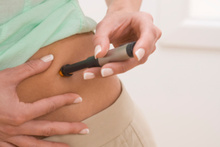 The pancreas prototype could be a breakthrough for the lives of those with type 1 diabetes who have to inject insulin daily.Photo / Thinkstock
The pancreas prototype could be a breakthrough for the lives of those with type 1 diabetes who have to inject insulin daily.Photo / Thinkstock
Australian researchers believe they are one step closer to developing an
artificial pancreas for people with diabetes. A Sydney-based diabetes expert
and a Queensland artificial intelligence specialist have tested the prototype
of a software program that could replicate the role of a human pancreas. If a
clinical trial works as well as the prototype, it could be a breakthrough for
the lives of those with type 1 diabetes who have to inject insulin daily, they
say.
Jenny Gunton from Sydney's Garvan Institute of Medical Research and
Nigel Greenwood of the University of Queensland say the device would work by
measuring a patient's blood glucose levels and delivering the dose of insulin
required - as a normally-functioning pancreas does. "The ultimate aim for
a 'mechanical cure' for type 1 diabetes would be to have a closed loop system -
where you have an insulin pump which knows how much insulin to give at the
right time," said Professor Gunton. "So you have glucose monitoring
and insulin administration in the same machine, with very smart pump software
keeping people's blood glucose normal."
In the project, funded by the Juvenile Diabetes Research Foundation, two
virtual patients had data supplied from real people with diabetes. Their
medical data, including blood glucose levels, was then simulated. The software
developed by Dr Greenwood, called Neuromathix, calculated suggested insulin
dosages for the patients and their blood glucose was analysed over 55 simulated
days. The researchers found that target blood glucose levels were achieved over
90 per cent of the time - compared to the average person with diabetes who hits
the target 60 per cent of the time. "What we have just done couldn't have
been done 10 years ago. We are dealing with a profoundly complex model
involving many unknowns," said Dr Greenwood. He hopes the software will
reach the market in 2016 after a clinical study and trial.
Source: NZ Herald
Please share
No comments:
Post a Comment